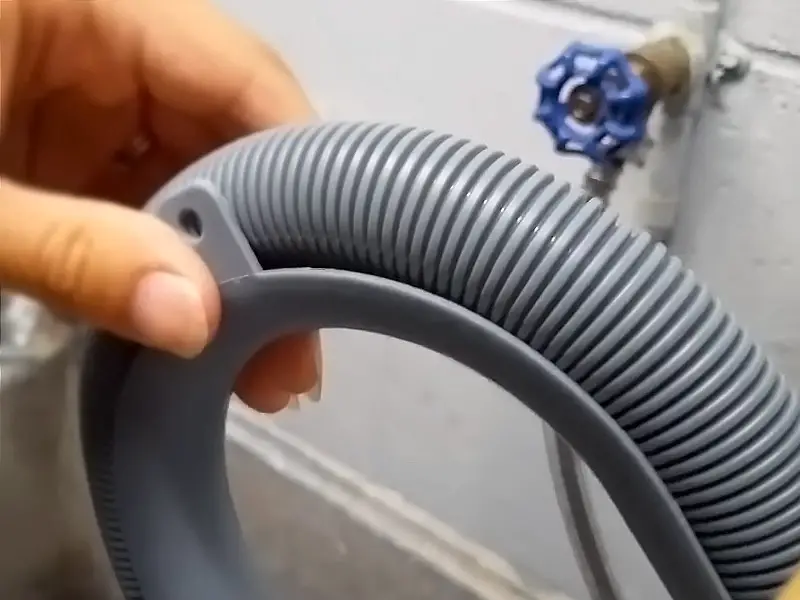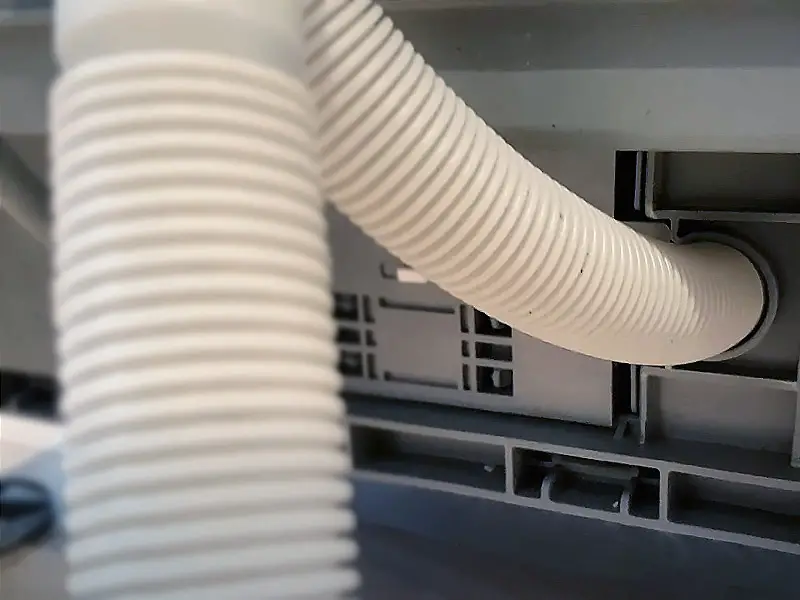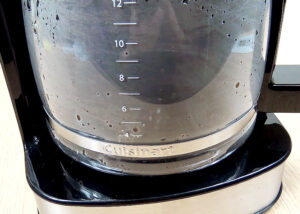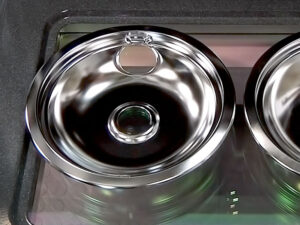A dishwasher is a vital part of the modern kitchen, streamlining the task of cleaning dishes. Ensuring that your dishwasher’s drain hose is clear is crucial for maintaining the appliance’s performance and preventing odors or backups. Over time, soap scum, food particles, and other debris can accumulate in the hose, leading to clogs and inefficiency.
With simple household items like vinegar and baking soda, you can effectively clean the drain hose and keep your dishwasher running smoothly. This process involves minimal effort and uses non-toxic ingredients, making it a safe and environmentally friendly solution. Regular maintenance using these items can extend the life of your dishwasher, save you the cost of potential repairs, and give you the peace of mind that comes with a well-functioning appliance.

Understanding the Importance of a Clean Drain Hose
Think of the drain hose as the unsung hero of your dishwasher’s ecosystem. It’s the crucial passage through which dirty water escapes, ensuring your dishes emerge spotless and sanitary. Overlooking the health of your dishwasher’s drain hose can lead to a cascade of performance issues. Let’s delve into why maintaining a clean drain hose isn’t just a recommendation—it’s a necessity.
Role Of Drain Hose In Dishwasher Performance
A clean and unobstructed drain hose is vital for optimal dishwasher functionality. This component transports used water out of the machine, paving the way for fresh water to cleanse your dishes. The hose must remain clean and clear to prevent water from stagnating inside the dishwasher, which can lead not only to poor cleaning results but also to an environment ripe for odor-causing bacteria.
- Facilitates efficient water flow: Ensures water exits quickly, allowing the cleaning cycle to run smoothly.
- Prevents backups: A clear hose stops water from backing up into the dishwasher, which could otherwise contaminate clean dishes.
- Aids in maintaining water pressure: Keeps the pressure consistent, helping the dishwasher’s pump efficiently circulate water.
Consequences Of A Clogged Drain Hose
Ignoring a clogged drain hose can have undesirable repercussions for your appliance. When the hose is restricted, water can’t exit the dishwasher properly, leading to a handful of problems:
| Issue | Consequence |
|---|---|
| Water stagnation | Creates unsanitary conditions, allowing bacteria and mold to flourish. |
| Odor development | Leads to persistent, unpleasant smells emanating from the dishwasher. |
| Reduced cleaning efficiency | Compromises dish cleanliness and demands repeated wash cycles. |
| Drainage issues | Results in water pooling at the bottom of the dishwasher. |
By undertaking regular maintenance and understanding how to clean your dishwasher’s drain hose without removing it, you’ll not only extend the lifespan of your appliance but also enjoy consistently clean and hygienic dishes. Ensuring that your dishwasher operates at peak performance translates to energy and water efficiency, which benefits both your wallet and the environment.
How to Identify a Clogged Dishwasher Drain Hose
Keeping your dishwasher in tip-top shape means ensuring all its components are running smoothly, particularly the drain hose. A clogged drain hose can spell disaster for your appliance, leading to water backup and potential damage. Understanding how to spot a clogged dishwasher drain hose is the first crucial step to maintaining a functional kitchen helper. Before you roll up your sleeves and tackle the grimy task, let’s dive into the telltale signs that indicate a blockage and review the methods for properly diagnosing the issue.
Signs Of A Clogged Drain Hose
Do you suspect a blockage in your dishwasher’s drain hose? Keep an eye out for the following key indicators:
- Poor Drainage: Water remaining after a wash cycle is a clear sign.
- Unpleasant Odors: Foul smells emanating from the dishwasher could hint at trapped food particles.
- Noises During Drain Cycle: Gurgling or humming sounds may suggest an obstruction.
- Visible Gunk: Observe the connection point where the hose attaches to the sink or garbage disposal for any visible buildup.
Inspection and Diagnosis Methods
Determining whether you have a blockage can be straightforward with the right approach:
- Visual Inspection: Begin with a visual check of the hose, especially at bends and connections.
- Manual Testing: Gently squeeze along the hose; if it lacks flexibility or feels bulged in areas, this may indicate a clog.
- Use of a Multimeter: If access permits, a multimeter set to the continuity mode can help detect obstructions without dismantling the hose.
- Dishwasher’s Self-diagnostics: Modern dishwashers often have self-diagnosis features. Consult your user manual to see if your model can pinpoint the problem.
Early detection and diagnosis are the keys to making sure your dishwasher’s drain hose remains clear and fully operational. Following these steps will help you identify any potential issues before they escalate into bigger problems.
Steps to Clean Dishwasher Drain Hose without Removing it
Many assume it’s a hassle involving the removal of the hose, but with our step-by-step cleaning process, you can keep your dishwasher running smoothly without dismantling your unit. Let’s keep your cleaning routine hassle-free and effective! Follow this guide to unclog and maintain your dishwasher’s drain hose seamlessly.

Gathering Necessary Tools And Supplies
Before we begin, let’s ensure we have all the tools and supplies at hand:
- Baking soda
- White vinegar
- Hot water
- Plunger (optional)
- Plumbing snake (optional)
- Bucket or container
Unclogging the Drain Hose
Let’s address the first line of action: unclogging the drain hose. Follow these steps:
- Disconnect your dishwasher from the power source.
- Locate the dishwasher drain hose connecting to the sink or garbage disposal.
- Place a bucket or container beneath the hose to catch any spillage.
- Detach the hose from the sink or disposal. A simple twist might be all that’s required.
- Inspect the hose and remove visible clogs with gloves or a straightened coat hanger.
- Reattach the hose and run a hot cycle to flush the remaining debris.
Using Natural Cleaning Solutions
Natural cleaning solutions can be both effective and safe for your dishwasher’s hoses. Try this eco-friendly method:
- Pour one cup of baking soda directly into the dishwasher’s drain.
- Follow with a cup of white vinegar, creating a fizzy chemical reaction that loosens grime.
- Allow the mixture to sit for 15-20 minutes.
- Boil a pot of water and pour it down the drain to flush the solution and any dislodged debris.
Utilizing Plumbing Tools
For stubborn clogs, you might need to introduce plumbing tools into your arsenal:
- Reattempt a cycle to check if the clog persists.
- If the clog remains, using a plunger can help. Place it over the drain, ensuring a good seal, and plunge vigorously.
- For even more stubborn clogs, carefully feed a plumbing snake down the drain hose to dislodge the blockage.
- Rewash with hot water to clear any remaining debris.
Regular maintenance using these methods can help you avoid the need for professional assistance, keeping your dishwasher in prime condition while preventing the inconvenience of a clogged system. Embrace these approaches as a part of your regular kitchen cleaning routine, and enjoy the peace of mind that comes with a well-maintained appliance.
Preventative Maintenance Tips
Preventative maintenance for your dishwasher’s drain hose is not just about avoiding clogs; it’s about ensuring peak performance and prolonging the life of your appliance. A dishwasher is integral to a modern kitchen, but overlooked aspects like the drain hose can cause unexpected headaches and messy cleanups if not maintained properly. The tips we’ll delve into don’t require the removal of the hose, making them convenient and user-friendly for even the most maintenance-averse homeowners.
Regular Maintenance Schedule
Maintaining a regular cleaning schedule is crucial to prevent buildup and ensure your dishwasher functions efficiently. A simple monthly routine can help avoid the need for more drastic measures.
- Monthly Inspection: Check the drain hose for any signs of kinking, blockage, or wear and tear.
- Flush with Vinegar: Run a hot water cycle with 2 cups of white vinegar in an empty dishwasher. The vinegar helps break down grease and debris.
- Baking Soda Rinse: After the vinegar cycle, sprinkle a cup of baking soda on the bottom of the dishwasher and run a short hot-water cycle. This will tackle odors and minor residue.
Best Practices For Keeping the Drain Hose Clean
Adopting best practices is the key to keeping the dishwasher drain hose free from obstructions and operational issues.
- Rinse Dishes: Ensure to pre-rinse dishes to remove large food particles before loading them into the dishwasher.
- Run Hot Water: Before starting a wash cycle, run hot water in the sink nearest to the dishwasher to aid in efficient cleaning from the get-go.
- Use the Right Detergent: Select a high-quality dishwasher detergent suited for your water hardness levels.
- Check for Large Residues: Periodically examine and clear the dishwasher filter of any trapped residues that could eventually affect the drain hose.
Following these preventative maintenance tips can significantly reduce the chances of drain hose clogs and contribute to a smoothly running dishwasher.
Frequently Asked Questions
Can Vinegar Clean Dishwasher Drains Effectively?
Yes, vinegar is an effective natural cleaner for dishwasher drains. Pouring a cup of white vinegar into the drain and letting it sit for 15 minutes can help break down debris and eliminate odors. Afterward, run a hot water cycle to flush the vinegar and loosened residues away.
How Do You Unclog A Dishwasher Drain Hose?
To unclog a dishwasher drain hose, start by disconnecting the dishwasher’s power. Bail out any standing water from the dishwasher, then pour a mixture of baking soda and vinegar down the drain hose. Wait 15 minutes for the solution to work before flushing with boiling water.
What Signs Indicate A Clogged Dishwasher Drain?
Signs of a clogged dishwasher drain include water not draining after cycles, an unusual odor, dishes not coming out clean, or pooling water at the bottom of the dishwasher. Hearing gurgling sounds can also suggest a blockage in the hose.
Is It Safe To Use Drain Cleaners In Dishwashers?
Generally, commercial drain cleaners are not recommended for dishwashers. They can be too harsh and damage the appliance’s components. Instead, use gentler alternatives like vinegar or baking soda mixtures to avoid damaging hoses and seals.
Final Words
Keeping your dishwasher in top condition is crucial for peak performance. Regularly flushing the drain hose maintains cleanliness and prevents blockages, all without the hassle of removal. Simple, effective techniques can ensure your appliance runs smoothly. Embrace these steps for a fresher, more efficient kitchen hero.







